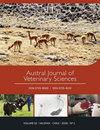Relationship between biochemical analytes and milk fat/protein in Holstein cows
IF 0.8
4区 农林科学
Q3 VETERINARY SCIENCES
引用次数: 2
Abstract
The aim of this study was to assess the relationship between biochemical analytes and milk fat/protein in high-yield (DIM: 42 ± 10 d postpartum) and low-yield (DIM: 91 ± 11 d postpartum) Holstein cows. Stepwise regression analysis was used to evaluate the relationships of biochemical analytes with the fat and protein content of the milk from 126 Holstein cows belonging to nine intensive housed dairy farms. The comparison between the two groups showed differences ( P< 0.05) in the milk yield, milk fat and milk fat/protein ratio, with the higher values in high-yield cows. The correlations between milk fat, milk protein, milk fat/protein ratio and biochemical analytes concentrations, were assessed within each group. Milk fat level was positively correlated to cholesterol, triglycerides, β-hydroxybutyrate and albumin in high-yield cows. Milk protein level was positively correlated to urea, and negatively correlated to sodium ion, potassium ion and chlorine ion in high-yield cows. A virtually linear dependence has also been found between milk fat and triglycerides, between milk protein and urea, and between milk fat/protein ratio and cholesterol, and triglycerides in low-yield cows. The metabolic profiles provide a practical tool, to present an insight into the underlying physiological mechanisms of lactation, and the identification of relationships between key analytes and components of milk, such as protein and fat content. Key words : dairy cow, blood chemistry, milk fat, milk protein.荷斯坦奶牛生化分析与乳脂/蛋白质的关系
本研究的目的是评估高产(产后DIM:42±10d)和低产(产后DIM:91±11d)荷斯坦奶牛的生化分析物与乳脂/蛋白质之间的关系。采用逐步回归分析方法,评价了9个集约化奶牛场126头荷斯坦奶牛的乳中生化分析物与脂肪和蛋白质含量的关系。两组奶牛的产奶量、乳脂率和乳脂蛋白比比较有显著性差异(P<0.05),其中高产奶牛的值较高。在每组中评估乳脂、乳蛋白、乳脂/蛋白比率和生化分析物浓度之间的相关性。高产奶牛的乳脂水平与胆固醇、甘油三酯、β-羟基丁酸和白蛋白呈正相关。高产奶牛乳蛋白水平与尿素呈正相关,与钠离子、钾离子、氯离子呈负相关。在低产量奶牛中,还发现乳脂和甘油三酯之间、乳蛋白和尿素之间、乳脂/蛋白比率和胆固醇以及甘油三酯之间存在几乎线性的依赖性。代谢谱提供了一个实用的工具,可以深入了解泌乳的潜在生理机制,并确定关键分析物和牛奶成分之间的关系,如蛋白质和脂肪含量。关键词:奶牛,血液化学,乳脂,乳蛋白。
本文章由计算机程序翻译,如有差异,请以英文原文为准。
求助全文
约1分钟内获得全文
求助全文
来源期刊

Austral Journal of Veterinary Sciences
Veterinary-General Veterinary
CiteScore
1.60
自引率
0.00%
发文量
18
期刊介绍:
Austral Journal of Veterinary Sciences (formerly Archivos de Medicina Veterinaria) publishes original scientific contributions in English, containing the latest developments and discoveries in veterinary sciences. The journal covers topics such as animal health and production, preventive medicine, zoonosis, pharmacology and therapeutics, methods of diagnosis, and other areas related to the veterinary field.
Austral Journal of Veterinary Sciences aims to divulge information about advances in veterinary medicine among universities, research centres, industries, government agencies, biologists, agronomists and veterinarians.
 求助内容:
求助内容: 应助结果提醒方式:
应助结果提醒方式:


